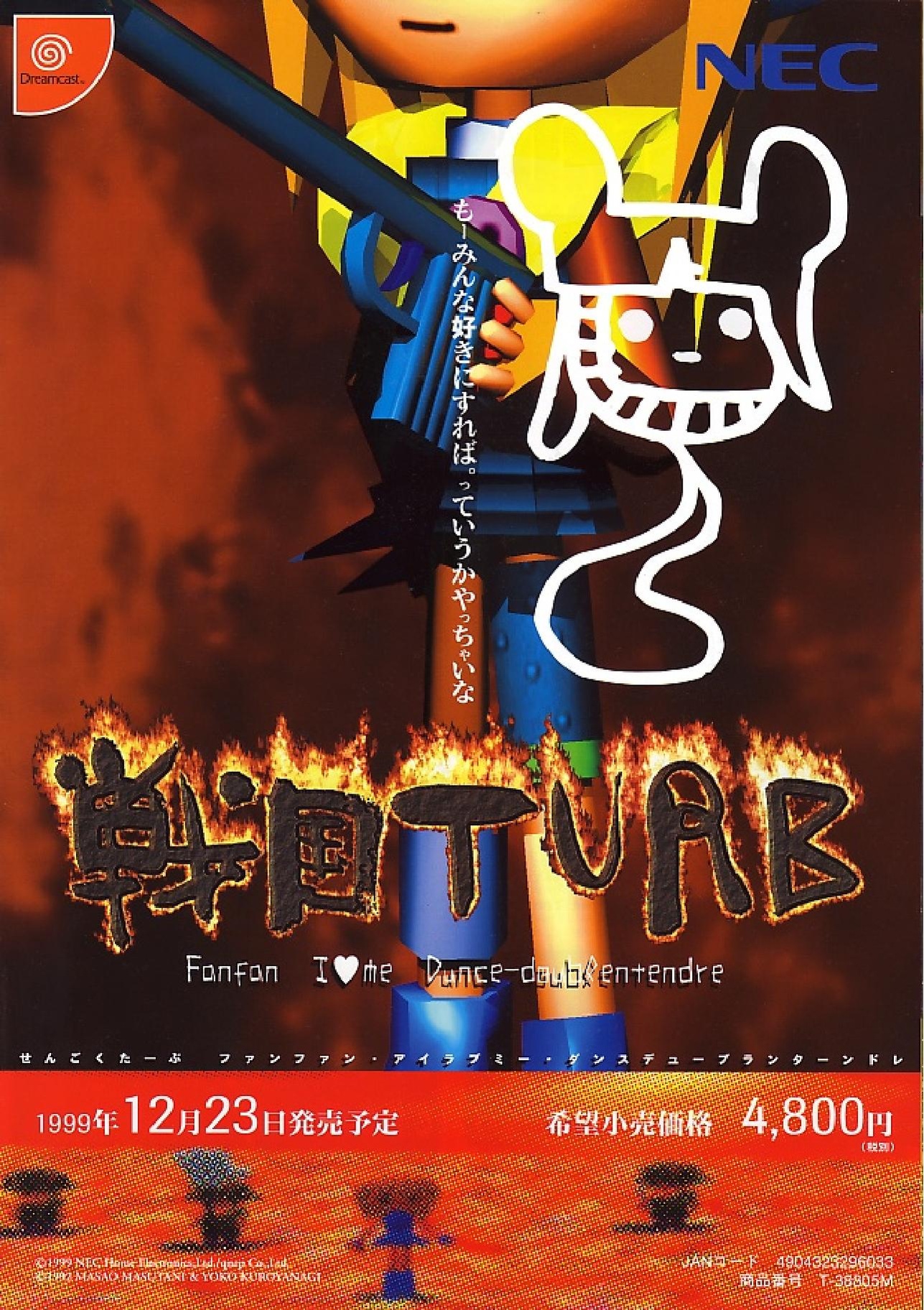Sengoku Turb: Fanfan I love me Dunce-doublentendre
From Sega Retro
| Sengoku Turb: Fanfan I love me Dunce-doublentendre | ||||||||||
|---|---|---|---|---|---|---|---|---|---|---|
| System(s): Sega Dreamcast | ||||||||||
| Publisher: NEC Home Electronics | ||||||||||
| Developer: NEC Home Electronics, qnep, Atypical Alchemists Associate | ||||||||||
| Peripherals supported: Jump Pack, Dreamcast Modem, Visual Memory Unit, Dreamcast VGA Box | ||||||||||
| Genre: Omnibus (オムニバス)[1][2], Table[3] | ||||||||||
| Number of players: 1-4 | ||||||||||
|
This short article is in need of work. You can help Sega Retro by adding to it.
Sengoku Turb: Fanfan I love me Dunce-doublentendre (戦国TURB Fanfan I ♥ me Dunce-doublentendre) is a follow-up to Sengoku Turb, also released exclusively in Japan in 1999. It appears to be nothing more than a minigame collection hidden underneath the veil of an RPG.
Sega of Japan's catalogue page refers to the game as Sengoku Turb: Fanfan I love me Dance-doubletendre, correcting the misspelt "dance" but missing a letter from "entendre".[2] It also abbreviates the name to Sengoku Turb F.I.D..
Contents
Production credits
- SENGOKU TURB Fanfan I♥me Dunce-doublentendre: Masao Masutani
- Producer / Director / Game Design / Story / Program / Graphics / Voice: Yoko Kuroyanagi
- Character Design / Scenario / Graphics / Voice: Harunobu Okubo
- Music Compose / Sound Effect / Voice: Kazuhiko Tomizawa, Kazumi Okubo
- Vocal: Jiro Aoyama
- Director / Program: Hiroo Matsuda
- Program: Nobuyuki Kihara, Naruki Sugeno
- Graphics: Masahiro Saito, Kaori Hirayama
- Music compose: Noriko Sato
- Character Design / Graphics / Voice: Seiko Okuda
- Graphics / Manual Design: Kuniyuki Takahashi
- Publicity / Promotion / Special Thanks: Tetsuya Iguchi, Hideya Tsurumoto, Goro Fukagawa, Nobuyuki Ichimori, Kouji Suganuma, Takeyuki Oda
- The Original: Masao Masutani, Yoko Kuroyanagi, Bio_100%
- Supervisor: Masao Takeuchi
- Executive Producer: Ataru Honsyo
- NEC Home Electronics,Ltd.
- qnep Co.,Ltd.
Magazine articles
Promotional material
Print advert in Dreamcast Magazine (JP) #1999-36ex: "1999-36 extra (1999/11/26ex)" (1999-11-12)
also published in:
also published in:
- Dreamcast Magazine (JP) #1999-38: "1999-38 (1999-12-10)" (1999-11-26)[4]
Print advert in Dreamcast Magazine (JP) #1999-39ex: "1999-39 extra (1999-12-24ex)" (1999-12-10)
Print advert in Dreamcast Magazine (JP) #2000-01: "2000-01 (2000-01-07,14)" (1999-12-24)
Physical scans
| Sega Retro Average | ||||||||||||||
|---|---|---|---|---|---|---|---|---|---|---|---|---|---|---|
|
| 85 | |
|---|---|
| Based on 2 reviews | |
Compliance
Technical information
External links
- Sega of Japan catalogue pages (Japanese): Dreamcast
References
- ↑ File:SengokuTurbFID DC JP Box Back.jpg
- ↑ 2.0 2.1 2.2 2.3 http://sega.jp/dc/991013/ (Wayback Machine: 2014-08-04 03:43)
- ↑ https://sega.jp/history/hard/dreamcast/software_l.html (Wayback Machine: 2020-02-01 22:57)
- ↑ Dreamcast Magazine, "1999-38 (1999-12-10)" (JP; 1999-11-26), page 18
- ↑ Dreamcast Magazine, "1999-40 (1999-12-31)" (JP; 1999-12-17), page 23
- ↑ Dorimaga, "2002-18 (2002-10-11)" (JP; 2002-09-27), page 32
Categories:
- Jump Pack-compatible games
- Dreamcast Modem-compatible games
- Dreamcast VGA Box-compatible games
- Visual Memory Unit-compatible games
- 1-4 player games
- JP Dreamcast games
- All JP games
- Dreamcast games
- 1999 Dreamcast games
- All 1999 games
- Dreamcast table games
- All table games
- Dreamcast games using Flash
- Dreamcast games with Sofdec video
- Dreamcast games containing VMU mini-games
- All games
- Stubs
- Credits without reference








